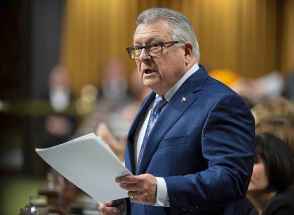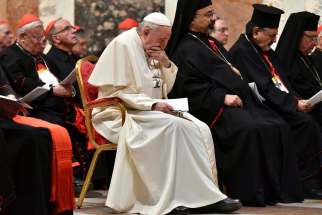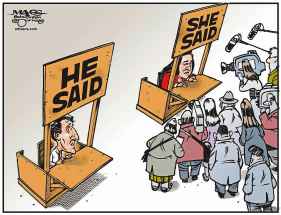No huge property-tax hike in Winnipeg’s 2019 budget
Read this article for free:
or
Already have an account? Log in here »
To continue reading, please subscribe:
Monthly Digital Subscription
$0 for the first 4 weeks*
- Enjoy unlimited reading on winnipegfreepress.com
- Read the E-Edition, our digital replica newspaper
- Access News Break, our award-winning app
- Play interactive puzzles
*No charge for 4 weeks then price increases to the regular rate of $19.00 plus GST every four weeks. Offer available to new and qualified returning subscribers only. Cancel any time.
Monthly Digital Subscription
$4.75/week*
- Enjoy unlimited reading on winnipegfreepress.com
- Read the E-Edition, our digital replica newspaper
- Access News Break, our award-winning app
- Play interactive puzzles
*Billed as $19 plus GST every four weeks. Cancel any time.
To continue reading, please subscribe:
Add Free Press access to your Brandon Sun subscription for only an additional
$1 for the first 4 weeks*
*Your next subscription payment will increase by $1.00 and you will be charged $16.99 plus GST for four weeks. After four weeks, your payment will increase to $23.99 plus GST every four weeks.
Read unlimited articles for free today:
or
Already have an account? Log in here »
Hey there, time traveller!
This article was published 01/03/2019 (2479 days ago), so information in it may no longer be current.
The sky isn’t falling after all.
Despite repeated threats from Mayor Brian Bowman warning of massive tax increases or infrastructure cuts or both to cope with a reported $40-million funding dispute with the Pallister government, the mayor and members of his executive policy committee tabled a preliminary 2019 budget Friday that proposes a property tax increase of 2.33 per cent — the same percentage increase for the fifth consecutive year.
Instead of the 9.4 per cent property tax increase Bowman had previously said was possible, the budget proposes to more than make up the shortfall from the province with a cut to its roads and sidewalk budget. While council in September approved spending $128.4 million for 2019 on roads and sidewalks, the budget lowers that amount to $86.4 million.
var paidAccessCheck = function(){
if($(“.paidaccess”).css(“display”) == “block”){
var data = {
“version”: “1.4.0”,
“id”: “xfCf2WgqYEYzfwpkz”,
“heading”: “Property tax increases”,
“qualifier”: “2009-present”,
“source”: “Source: City of Winnipeg”,
“tags”: [],
“chart”: {
“class”: “primary”,
“hasHours”: false,
“data”: “2008,0n2009-01-01,0n2010-01-01,0n2011-01-01,0n2012-01-01,3.5n2013-01-01,3.9n2014-01-01,2.95n2015-01-01,2.3n2016-01-01,2.3n2017-01-01,2.3n2018-01-01,2.3n2019-01-01,2.3”,
“options”: {
“annotations”: true,
“expanded”: false,
“footer”: true,
“head”: true,
“indexed”: false,
“interpolation”: false,
“legend”: true,
“qualifier”: true,
“share_data”: true,
“social”: true,
“stacked”: false,
“tips”: true,
“type”: “column”,
“x_axis”: true,
“y_axis”: true
},
“x_axis”: {
“display”: true,
“scale”: “time”,
“ticks”: “auto”,
“orient”: “bottom”,
“format”: “comma”,
“nice”: false
},
“y_axis”: {
“display”: true,
“scale”: “linear”,
“ticks”: “auto”,
“orient”: “right”,
“format”: “comma”,
“suffix”: “%”,
“max”: “5”,
“nice”: true
},
“annotations”: {
“highlight”: [],
“range”: [
{
“axis”: “x”,
“start”: “Wed Jan 01 2014 00:00:00 GMT-0600 (Central Standard Time)”
}
],
“text”: [
{
“text”: “Bowman”,
“valign”: “top”,
“text-align”: “left”,
“position”: {
“x”: 0.5498,
“y”: 0.0238
}
},
{
“text”: “Katz”,
“valign”: “top”,
“text-align”: “right”,
“position”: {
“x”: 0.5336,
“y”: 0.021
}
}
],
“pointer”: []
}
}
};
root.ChartTool = root.ChartTool || [];
root.ChartTool.push({id: “ct-” + data.id, data: data});
var b = document.getElementsByTagName(“body”)[0];
if (!b.classList.contains(“ct-charttool-init”)) {
b.classList.add(“ct-charttool-init”);
var c = document.createElement(“link”);
var j = document.createElement(“script”);
c.href = “https://wfpdata.s3.amazonaws.com/chart-tool/v4/chart-tool.css?token=0”; c.rel = “stylesheet”;
j.src = “https://wfpdata.s3.amazonaws.com/chart-tool/v4/chart-tool.js?token=0”; j.async = true; j.defer = true;
document.getElementsByTagName(“head”)[0].appendChild(c);
document.getElementsByTagName(“head”)[0].appendChild(j);
}
clearInterval(verifyPaidAccess);
}
}
var verifyPaidAccess = setInterval(paidAccessCheck,100);
})(this);
The City of Winnipeg said the impact of the property tax bump on the average home will be about $40 (a tax bill of $1,774 for a home assessed at $296,560).
“Preparing this year’s budget was complicated by ongoing uncertainty regarding provincial government funding support to the city,” Bowman told reporters. “I fully support the provincial government’s efforts to eliminate its budget deficit but I don’t believe this should be achieved on the backs of Winnipeg property taxpayers.”
Total spending by the city will climb 3.9 per cent, to $1.22 billion — more than double the 1.2 per cent increase between 2017 and 2018.
Aside from the reduction in the planned amount of infrastructure spending, the 2019 preliminary budget shows little impact from city hall’s public feuding with the Manitoba government:
- No staff layoffs.
- The police spending increases 3.4 per cent, to $301.4 million.
- The fire paramedic spending increases 4.2 per cent, to $201.5 million
- The business tax rate will be reduced for the fifth year in a row.
- Freezes on water and sewer rates, transit fares, frontage levies, parking rates.
- No new fees
var paidAccessCheck = function(){
if($(“.paidaccess”).css(“display”) == “block”){
var data = {
“version”: “1.4.0”,
“id”: “8zR2ben6iSHkXArjj”,
“heading”: “Emergency services operating budget”,
“qualifier”: “Adjusted for inflation”,
“source”: “”,
“tags”: [],
“chart”: {
“class”: “primary”,
“hasHours”: false,
“data”: “year,Fire and paramedics,Police servicesn2009-01-01,129.5,178.9n2010-01-01,137.6,189.9n2011-01-01,143.0,202.1n2012-01-01,154.8,220.2n2013-01-01,167.9,242.5n2014-01-01,167.6,257.9n2015-01-01,178.3,264.0n2016-01-01,190.2,280.7n2017-01-01,199.2,288.0n2018-01-01,193.5,291.4n2019-01-01,201.2,301.4”,
“options”: {
“annotations”: true,
“expanded”: false,
“footer”: true,
“head”: true,
“indexed”: false,
“interpolation”: “linear”,
“legend”: true,
“qualifier”: true,
“share_data”: true,
“social”: true,
“stacked”: false,
“tips”: true,
“type”: “line”,
“x_axis”: true,
“y_axis”: true
},
“x_axis”: {
“display”: true,
“scale”: “time”,
“ticks”: “auto”,
“orient”: “bottom”,
“format”: “comma”,
“nice”: false
},
“y_axis”: {
“display”: true,
“scale”: “linear”,
“ticks”: “auto”,
“orient”: “right”,
“format”: “general”,
“prefix”: “$”,
“suffix”: “M”,
“nice”: true
},
“annotations”: {
“highlight”: [],
“range”: [],
“text”: [],
“pointer”: []
}
}
};
root.ChartTool = root.ChartTool || [];
root.ChartTool.push({id: “ct-” + data.id, data: data});
var b = document.getElementsByTagName(“body”)[0];
if (!b.classList.contains(“ct-charttool-init”)) {
b.classList.add(“ct-charttool-init”);
var c = document.createElement(“link”);
var j = document.createElement(“script”);
c.href = “https://wfpdata.s3.amazonaws.com/chart-tool/v4/chart-tool.css?token=0”; c.rel = “stylesheet”;
j.src = “https://wfpdata.s3.amazonaws.com/chart-tool/v4/chart-tool.js?token=0”; j.async = true; j.defer = true;
document.getElementsByTagName(“head”)[0].appendChild(c);
document.getElementsByTagName(“head”)[0].appendChild(j);
}
clearInterval(verifyPaidAccess);
}
}
var verifyPaidAccess = setInterval(paidAccessCheck,100);
})(this);
Bowman told reporters the “responsible” way to address the $40-million shortfall was to reduce the number of road projects rather than recover the entire amount through an additional 7.1 per cent property tax increase.
Council will be asked to make up half of the $40 million from the 2019 local street renewal reserve fund. The remaining $20 million will be referred to the 2020 capital budget process.
Bowman said reduced spending on roads in future years will become "the city’s new reality."
Rolling back infrastructure spending means fewer roads will be repaired, but $86.4 million remains a significant amount compared to the spending during the 10 years of the Sam Katz administration (2004-14), and is slightly more than the $84 million council approved in 2014.
Also affected by the infrastructure rollback will be sidewalks, bike trails and pedestrian pathways — $2.7 million less than was projected in the 2018 budget, and a total of $17.5 million over six years.
Budget highlights
How much money does the city need this year for its current operating budget? $1.124 billion. What kind of a property tax increase is the city looking for? The proposed budget calls for a 2.33 per cent property tax increase, the same annual increase Mayor Brian Bowman campaigned for during the civic election. And, as the city is mandated to do, the tax-supported budget is balanced. What does it mean to your wallet? If your home is worth $296,560 — the average cost of a house here — you’ll be paying an additional $40.38. That means your tax bill (not including what you’ll be paying to your local school division) will go from $1,733 to $1,774. How much money does the city need this year for its current operating budget? $1.124 billion. What kind of a property tax increase is the city looking for? The proposed budget calls for a 2.33 per cent property tax increase, the same annual increase Mayor Brian Bowman campaigned for during the civic election. And, as the city is mandated to do, the tax-supported budget is balanced. What does it mean to your wallet? If your home is worth $296,560 — the average cost of a house here — you’ll be paying an additional $40.38. That means your tax bill (not including what you’ll be paying to your local school division) will go from $1,733 to $1,774. What will that extra tax money go to? The city says the entire 2.33 per cent increase goes to infrastructure, not for salaries or to pay for new goodies. It’s all for streets. Two per cent would go to rebuilding and repairing regional and local roads, while the rest, .33 per cent, would go to complete the Southwest Rapid Transitway. I’ve heard the city is at loggerheads with the provincial government over funding — what does that mean for the city’s budget and my pocketbook? A lot, according to the proposed budget. There will be slashes throughout the budget including: — Spending only $86.4 million on regional and local road renewals and repairs in 2019, down from the proposed $128.4 million. It would be the lowest annual expenditure since 2014. — Reducing the city’s overall road renewal plan from $976 million over the next six years to $801 million. — Cutting spending on sidewalks, bike corridors and recreational walkways from almost $5.7 million to $3 million, a near-50 per cent reduction. What new things is the city spending money on? • The city plans to strip away part the corporate support services department for a new innovation, transformation and technology department. It will take the old department’s $20 million budget for innovation needs and add an additional $4.6 million to it. • Transit bus drivers will finally be protected by safety shields. The city will spend $3.15 million over the next year for their purchase and installation. • The purchase of 34 new buses at a cost of $22.2 million. • A plan to spend more than $1 million for more heated bus shelters. • Implementing a low-income bus pass, but it won’t start until April 2020. The pass would give a 30 per cent discount for adult monthly passes in 2020, 40 per cent in 2021 and 50 per cent starting in 2022. • Spending $1 million to study how to incorporate electric buses into the current transit system and to create a budget estimate for buying between 12 and 20 battery-electric vehicles. • No new fees are proposed. No water and sewer rate increases. No frontage levy rate increase. Parking rates will not go up. Who are the winners in this budget? • Bus riders. For the first time since 2007, transit fares will not go up. • Police officers. The Winnipeg Police Service is one of the few departments, along with Winnipeg Fire Paramedic Service, that will get an increase higher than the cost of living. The budget proposes giving it an extra $9.9 million, up from $291.5 million to $301.4. The police budget has jumped 14 per cent since 2015. • Firefighters. The department will get a budget increase of 4.2 per cent. As well, they will get more than $16 million in capital support to pay for a new computer-aided dispatch system, new air compressors, cardiac monitors and defibrillators and power stretchers, and $3.4 million to maintain and repair fire-paramedic stations. • Community Centres. The city-owned ones needing repairs will have more money to draw from. The city is looking at doubling the funding to the Community Centre Renovation Grant Program from just under $1 million to $2 million and increasing eligible grants from $50,000 to $100,000. There are 63 community centres across the city. • Winnipeg’s rivers. The city is looking at spending $31 million this year, part of a $169 million plan over six years, to reduce the amount of sewage getting out of the city’s combined sewer overflow into rivers during major rain events. The city is hoping to reduce sewage overflows into the rivers by at least 85 per cent by 2045. • Athletes and culture lovers. Museums, community centres and other organizations will get a $42.9 million in grant support this year. How much do we pay for our police and fire protection? A lot. Between the two of them, the Winnipeg Police Service and the Winnipeg Fire Paramedic Service account for $503 million, or 45 per cent, of the city’s entire tax-supported budget. Property taxpayers have to pay more in this budget; how about small businesses? The city proposes to reduce the business tax from 5.14 per cent to 4.97 per cent while also increasing the business tax threshold from $33,300 to $33,900. This is about a 13 per cent decrease from 2014, as the city moves toward the tax’s eventual elimination. There are 5,842 businesses which will benefit from the changes. Will the city have to lay off any employees to meet its budget? No, the city is proposing an $18 million vacancy management target, to be shared by all departments, to reduce employees through attrition, but not through layoffs. Will our water and sewer bills subsidize our tax dollars? Yes, but not as much as before. For the first time since it was put into place in 2011, the city will reduce the water and sewer dividend rate from 12 to 11 per cent. This is the amount taken from water and sewer and put into general revenue. The city says this will help the city fund the wastewater treatment infrastructure, which the province has ordered it to do. How much of the city’s budget relies on taxes paid on our homes? If you think of the city’s budget needs as a large fruit pie, property taxes represent a 54 per cent slice. The next largest slice comes from provincial government grants at 12.8 per cent, followed by 5.6 per cent from frontage levies. Other slices include business tax, at 5.1 per cent, licences, fees and fines at 5.2 per cent and sales of goods and services at 4.9 per cent. What about the capital budget, which pays for major construction projects in the city including roads, bridges, underpasses, police stations and park upgrades? The city is proposing spending $367.5 million this year, a bit less than the $380.1 million it spent last year. The city is also budgeting to spend $2.3 billion in capital investment in the next six years. What will this budget pay for over the next six years? More than $800 million on renewing existing local and regional roads, more than $169 million to reduce combined sewer overflow incidents, more than $11.8 million to build a new recreation facility in Waverley West and more than $23 million for the urban forest enhancement program. The city is also proposing sliding up to $3 million now into the 2020 capital budget for renovating and renewing Rainbow Stage. This project is subject to Rainbow Stage’s board successfully securing matching funds from other levels of government and private donors. What happens now? City committees: infrastructure renewal and public works; water and waste, riverbank management and the environment; protection, community services and parks; and the Winnipeg Police Board now get a chance to look through the budget and allow the public to give feedback before it goes back to Executive Policy Committee before going to city council. When will we know how much we will really pay? Both the current and capital budgets will be passed by city council on March 20. — Kevin Rollason
Finance chairman Coun. Scott Gillingham said the preliminary budget was produced by the EPC, but it also reflects concerns from other members of council and the public.
"We are dealing with a new fiscal reality with the province of Manitoba," he said.
Gillingham said revenue collected from the impact fee (the charge on new residential development on the suburban areas) will continue to be held in a reserve account and not used for spending this year.
Total capital projects spending for 2019, including utilities and special operating agencies, is set at $367.5 million, a reduction of $12.5 million from 2018.
There is $2.1 million set aside for continued planning on the Kenaston Boulevard/Route 90 widening but no funds for construction. The Arlington Street bridge replacement was not identified as a project.
Those hoping to see an introduction of a low-income bus pass this year will be disappointed. However, that’s planned to be introduced in April 2020, with a 30 per cent discount on the full adult fare, rising to 50 per cent in 2022.
Winnipeg Transit will benefit with the purchase of 34 new buses, $1 million for heated bus shelters, and $500,000 for improving bus stop accessibility.
The budget will also see a reduction in dividends taken from water and sewer rates — to 11 per cent from 12 per cent. (The dividend is the amount of revenues from the water and waste department that is skimmed off to offset property taxes. The Katz administration imposed an eight per cent dividend in 2011; Bowman increased it to 12 per cent in his first budget in 2015.)
var paidAccessCheck = function(){
if($(“.paidaccess”).css(“display”) == “block”){
var data = {
“version”: “1.4.0”,
“id”: “6oDMDWthhjx2QaYG9”,
“heading”: “Budget change from last year”,
“qualifier”: “Expenditures by department”,
“source”: “* In 2018, Innovation and Information Technology, Customer Service and Communications, and Human Resources were reported in CorporatenSupport Services (CSS). CSS was reorganized into individual departments for 2019.”,
“tags”: [],
“chart”: {
“class”: “primary”,
“hasHours”: false,
“data”: “department,change nInnovation/technology*,18.63nPlanning,7.83nAssessment ,4.76nCustomer service,4.30nFire ,4.00nWater and waste,3.83nOther ,3.44nCommunity services,3.37nPolice,3.31nClerks,2.94nPublic works,1.37nCorp. finance,0.18nStreet lighting,-1.44nHuman Resources,-2.21”,
“options”: {
“annotations”: true,
“expanded”: false,
“footer”: true,
“head”: true,
“indexed”: false,
“interpolation”: false,
“legend”: true,
“qualifier”: true,
“share_data”: true,
“social”: true,
“stacked”: false,
“tips”: true,
“type”: “bar”,
“x_axis”: true,
“y_axis”: true
},
“x_axis”: {
“display”: true,
“scale”: “linear”,
“ticks”: “auto”,
“orient”: “bottom”,
“format”: “round1”,
“suffix”: “%”,
“nice”: false
},
“y_axis”: {
“display”: true,
“scale”: “ordinal”,
“ticks”: “auto”,
“orient”: “right”,
“format”: “comma”,
“nice”: false
},
“annotations”: {
“highlight”: [
{
“key”: “Human Resources”,
“color”: “#d6616b”
},
{
“key”: “Street lighting”,
“color”: “#d6616b”
}
],
“range”: [],
“text”: [],
“pointer”: []
}
}
};
root.ChartTool = root.ChartTool || [];
root.ChartTool.push({id: “ct-” + data.id, data: data});
var b = document.getElementsByTagName(“body”)[0];
if (!b.classList.contains(“ct-charttool-init”)) {
b.classList.add(“ct-charttool-init”);
var c = document.createElement(“link”);
var j = document.createElement(“script”);
c.href = “https://wfpdata.s3.amazonaws.com/chart-tool/v4/chart-tool.css?token=0”; c.rel = “stylesheet”;
j.src = “https://wfpdata.s3.amazonaws.com/chart-tool/v4/chart-tool.js?token=0”; j.async = true; j.defer = true;
document.getElementsByTagName(“head”)[0].appendChild(c);
document.getElementsByTagName(“head”)[0].appendChild(j);
}
clearInterval(verifyPaidAccess);
}
}
var verifyPaidAccess = setInterval(paidAccessCheck,100);
})(this);
aldo.santin@freepress.mb.ca
History
Updated on Friday, March 1, 2019 2:39 PM CST: Updates charts
Updated on Friday, March 1, 2019 5:41 PM CST: writethrough











